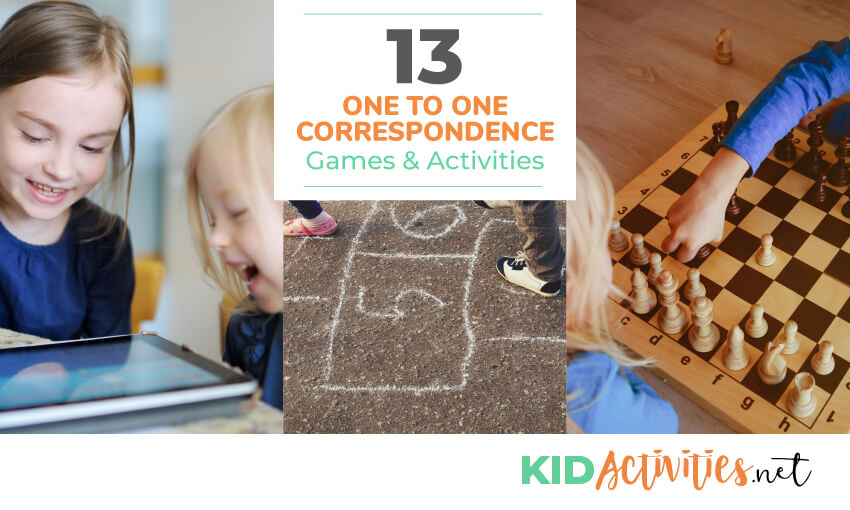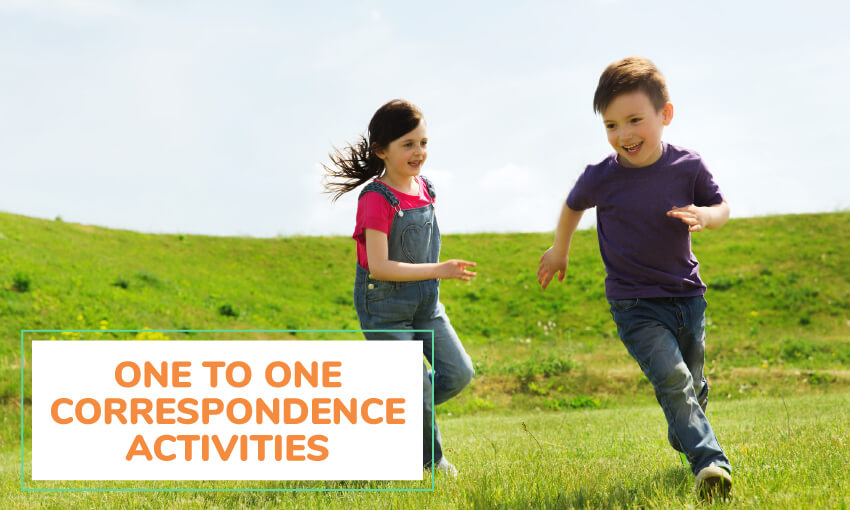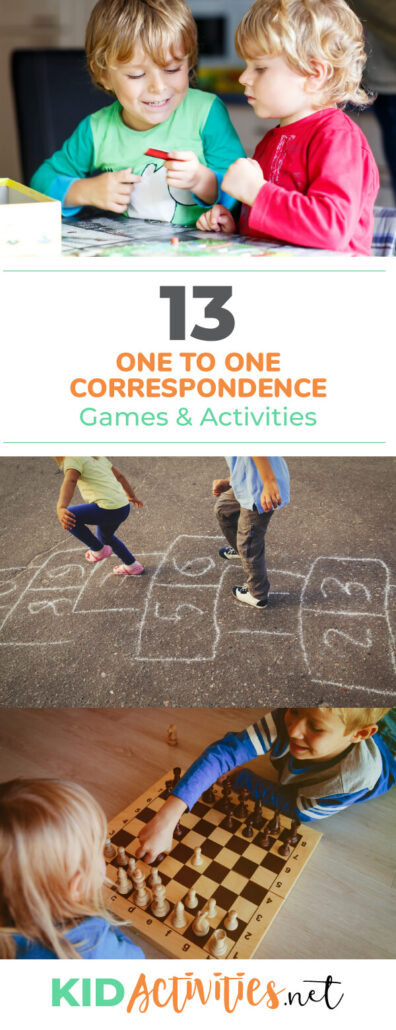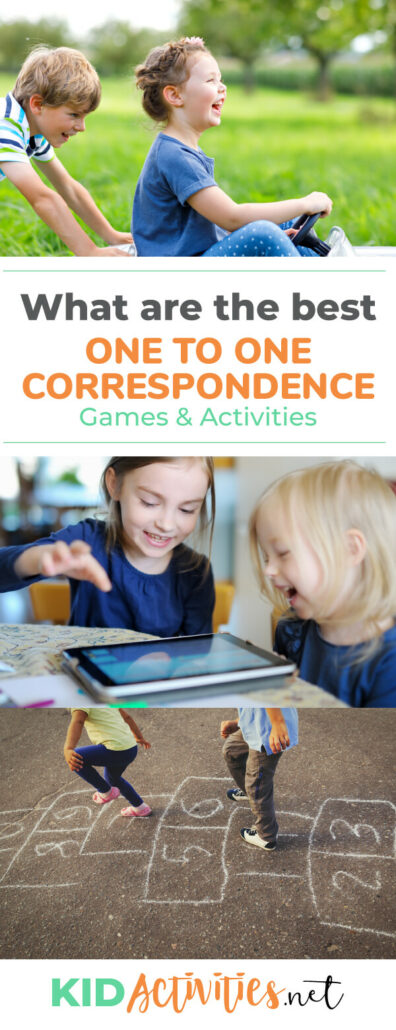One to One Correspondence Activities and Games
Do you want to teach your kids one to one correspondence? Help your child develop math skills early with any of these 13 one to one correspondence activities and games.
If you are like most people you probably enjoy watching your child grow, develop, and learn. It’s fascinating how such small tasks can excite the smallest child and it’s probably just as fascinating watching you jump and clap with the completion of each of those tasks.
You might not realize that they start learning as soon as they come out of the womb. Simple things from learning who all the strangers are in the room to more advanced things like sleeping on their own are tasks they will continue to learn as they grow.
From the time they are 4-months old, they learn tasks such as grasping a rattle and trying to hold their own bottle. At 6-months old, they start to play and by the time they are a year old they are learning to stack blocks and giggle as Mom knocks them down. That seems to be the perfect time to introduce them to someone to one correspondence games and activities.
In this post you will find:
- Definition of One to One Correspondence
- Learn how to Teach One to One Correspondence
- Activities and Games for One to One Correspondence Child Development
- One to one Correspondence Activities for Kindergarten
- Counting Bears Game
- The Development of Counting Sills
What is One to One Correspondence?
One to one correspondence is an early, but simple form of math that a toddler learns as early as 2 years of age. When they begin to recognize, match, and count objects, they are learning one to one correspondence. Simply put, they are counting sets of matching elements. Each object in front of them will have a matching number; each cookie has a number, each piece of candy has a number, and each person in the room has a number.
How to Teach One to One Correspondence
The teaching process of one to one correspondence is simple and probably something you have been doing already and didn’t even know it. During the teaching process, use objects that are fun and colorful for your toddler. Using things like blocks, animal crackers, and small balls work well. Using books with colorful and numbered patterns are always a good choice as well. Whatever you decide to use, line the objects in a row close together and count them as you set them in place. Ask your child to place a finger on each one and count them down the row. Touch is important for understanding. Use colorful objects and say, one blue block, two yellow blocks, etc. Once they count them down the row mix them up and have them start from the beginning once again. This is to assure they understand and that they haven’t memorized an order of sequence.
One to One Correspondence Activities
The activities that you choose can be as simple or as complex as you want them to be. Most of the activities can be created with household items, but there are some things you can purchase to include in the fun. One to one correspondence activities is best absorbed when you sit down one on one with your child giving them your full attention and guidance.
1. Counting Fruity O’s
This activity is fun and tasty too! Using fruity O cereal, you can simply place some in a bowl and ask your little one to count out each color consecutively. For example, tell them to count out the purple ones, then the red ones, etc. Start out the younger ones with up to 5 of each color and then gradually increase the number as they improve their skills. Don’t forget to mix it up so they don’t count the colors from memorization. This activity is great for helping you towards your preschool goals of learning and color recognition.
2. Counting Owls
[amazon box=”B01A5YLW5C”]The Counting Owls Activity set will not only teach your child one to one correspondence skills, but color recognition and fine motor skills can be strengthened with this activity as well. It’s a 37-piece set that is complete with 10 cards, 25 owls with 5 different colors, a spinner, and a perch for the owls to sit on. The owls are plastic and just the right size for little hands. They are colorful and fun with a perch that provides a place for the owls to snap into and the numbers on the perch will show your child how many owls to snap together in each row. The spinner and activity cards also provide numbers and fun math skills. They can learn to count to 10 and even learn how to group and sort the owls. This is a fun activity that will give your child years of experience learning math. It’s recommended for children ages 3 years and older, but younger ones can enjoy it too once they learn that putting the owls in their mouths is not such a good idea.
3. Smart Snacks Number Pops Set
[amazon box=”B00I0CEDK8″]This cool activity will have your toddler craving the fun of learning. The number pops are colorful and the outside displays a bold number while the inside displays a matching number of dots. You can mix up the covers and ask your little one to match them up, but first, be sure they point to each one in order as they count them out loud. This is a great one to one correspondence activity and it will teach them colors, number recognition, and eye-hand coordination. As your child grows you can use this set of ten pops for learning more advanced math skills. They can even try and get you to match them up correctly.
Kids will also enjoy pretending they are selling ice cream from a truck or stand that you can make from cardboard. The pretend customer can ask for a pop with a certain number on it and they will have to sell them the proper one. You can even incorporate some play money into this fun activity. This is a great way to teach without your children knowing they are learning.
4. Play-Doh Cakes
[amazon box=”B00JM5GW10″]Using different colors of play-doh is another way to have fun and learn at the same time. Set up a table and cover it with paper to avoid any unnecessary mess. Let your child pretend to make cakes. They can make one cake of one color, two cakes of another, three of the next, and so on until they have made cakes using all the colors. So, they will have one red, two yellow, three green, etc. When they are finished with the cakes, ask them to gather their favorite dolls and stuffed toys. If they have ten cakes they will need ten toys. Allow them to set up a picnic with their toys then assign a corresponding play-doh color with each toy. Ask them to count out the appropriate cakes for each toy. This will teach them one to one correspondence, eye-hand-coordination, and it will test their listening and thinking skills too.
5. Counting Bears
[amazon box=”B01DFRDDTY”]Grown-ups know how dangerous real bears are, but toy bears can be so much fun, and so that’s why this activity is one to include in your basket of learning fun! There are 60 of these exciting rainbow counting bears with 6 matching cups, a handy cup with a lid for storage, and a colorful bear dye. Think of all the fun and imagination that can be created with this activity.
You can line up the cups, mix up the bears, and ask your little one to separate and count out the correct number of bears as they put them in the matching colored cup. Small children enjoy putting objects in things and dumping them out, so why not ask them to put 5 blue bears in the blue cup and then dump them out and start over by putting 3 green bears in the green cup? It’s unbelievable how long a 3-year-old will occupy themselves with counting, sorting, and then dumping them out again, but if that isn’t enough this set also comes with an e-book filled with downloadable activities for hours of enjoyment.
One to One Correspondence Games
Some of the games you choose in your child’s learning process can be created at home just like the activities, but there are some really cool games that you can buy too. One to one correspondence games can be fun when played with more than one child, so if you’re stuck inside on a rainy day with all your young ones, sit down and play one of the following games with them.
6. Dino Math Tracks Game
[amazon box=”B00004TDKU”]Another great way to incorporate fun into learning is this Dino Math Tracks game. The game board is filled with three rows of dino tracks, each row features a specific color track with their own number and a different level of play. Each player chooses 4 dinosaurs of the same color. They will take turns rolling the 4 dice, they can then line up the numbers in any way they choose. They will match up each dino with each die and move according to the number they roll on each one. The older kids will enjoy playing the game using the problem-solving cards and for the younger kids, you can use less dice and animals. There are many different options with this game and it will be enjoyed the most from ages 6 and older.
7. Number Toss Game
[amazon box=”073534941X”]This is the perfect game to keep your 1-3-year-olds occupied on a rainy day. For this game, you will need number cards with pictures, bean bags, and a laundry basket. Mix up the cards and each child can take turns picking a card. Once they have chosen their card, help them to recognize the number and count the matching number of objects on the card. Once they have mastered the number ask them to pick up the same amount of bean bags from a nearby pile. Stand them near the laundry basket and tell them to try and toss the bean bags into the basket one at a time while counting each one out loud. When their turn is over, they can pick up the bean bags and count them again as they put them back in the original pile. If you are playing with only one child, you can participate too, kids love to play with the grownups.
8. Bucket of Blocks
Another game that is easy for teaching one to one correspondence with little ones is a simple bucket of blocks game. Using blocks with paired shapes and colors and a small sand bucket, your toddlers will stay busy for hours. Set them on the floor and tell each one to choose different color and shape. Once they choose, ask them to tell you which ones they have. Next, ask them to pick out all the other blocks with the same color and shape. Once they have finished the task then you should ask each child, one at a time to place a finger on each one and count them out loud. Place the bucket in the center of the room and line the kids up. Standing in front of the bucket, each child should take a turn dropping their shapes into the bucket counting each one as they drop. You can award the child who gets the most in the bucket, or you can award them all for trying. When the game is finished try again by taking them all to swap the shapes and start again.
Counting Games for Kindergarten 1-20
By the time your little ones hit kindergarten age, they are already counting and learning simple math. You know your child’s learning level better than anyone, so by the time they get to this age keep them occupied with some fun counting and math activities.
9. Counting Mats
[amazon box=”B071VZWZB9″]These fun counting mats are designed with twenty spaces each with their own picture scenes and numbers. They are intended to be used with play-doh or putty, so your child can finish the pictures by molding a designated number of objects to match on the spaces. For example: one space shows a number 14 with the same number of French fries in the picture. Your little one can happily mold 14 fries and place them in the correct places on the mat. It’s a colorful mat with 20 squares, so the mat can grow with your child’s skills. The mat measures 10×15 and are laminated for easy cleanup. You could use this one for fun at restaurants using straws or coins while you wait for the main course to arrive.
10. Egg Carton Counting
Using an egg carton and objects this activity can be used at a station for counting and math skills. You can write single numbers in the egg sections or you can write in simple math problems for the kids to solve. They will need to count out the number of objects that are needed to place in each section of the carton. You can incorporate this into different stations for increased levels of learning; single numbers, addition, and subtraction. This makes for a great sensory play idea.
Development of Counting Skills
It’s essential that your child understands that with each object there is a number attached. For them to develop the counting skills they need you can introduce them to games and activities, so they won’t get frustrated while they’re learning. Remember to use the pointing system and ask them to count out loud so you can help them if they get stuck along the way.
11. Sum Swamp Game
[amazon box=”B00004TDLD”]The Sum Swamp game is a fun game for the early development of counting and simple math. This game comes with a board designed as a swamp. 2-4 kids ages 5 and up can play this game as they compete to be the first to get their swamp animals around the board. They each take a turn rolling the dice; there are two dice with numbers and the other one displays a plus or minus sign. Once they roll they will need to put the numbers together with the plus or minus to decide how many spaces they will advance on the board. There are fun little twists along the way that will have them cheering with excitement. This is a great way to introduce basic math skills along with number recognition and counting, not to mention the fun they will have without knowing they are learning.
12. Counting Buttons
This is a simple activity that you can create at home using what you already have. Grab some different colored buttons, cupcake papers to match, and write a number at the bottom of each paper. If you have three papers, number each one from 1-3. Then you can ask your child to separate the colors of the buttons. If the pink paper has a number one on the bottom, then they will need to find one pink button to place in there. If the white paper is numbered with a two they will then need to find two white buttons to put in the paper and so on until each cupcake paper has the correct amount of matching colored buttons in each one. You can also use muffin tins or other containers with separations if you don’t have cupcake papers on hand.
13. Counting Ladybugs
[amazon box=”B076W94SQH”]Children as young as 3-years old will enjoy counting ladybugs. This box is filled with 96 ladybug cards with numbers printed on one side and dots on the other. They are easy for small hands to hold while they try and match the number with the corresponding dots. They can also pick a card with a number and count out the matching number of ladybugs. This one is simple and compact, so you can take the fun with you anyplace you go.
Make sure you check out some of our other great posts:





